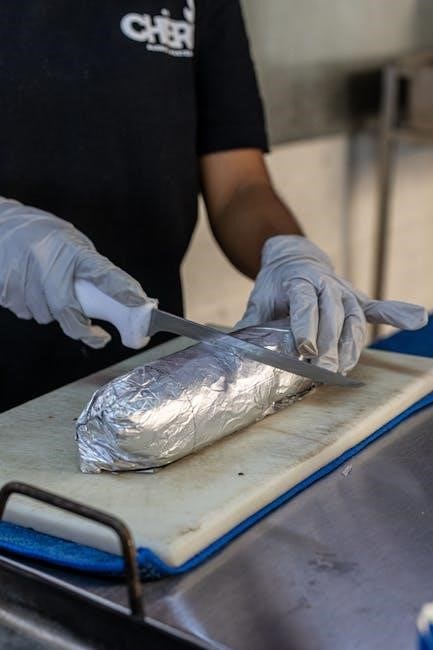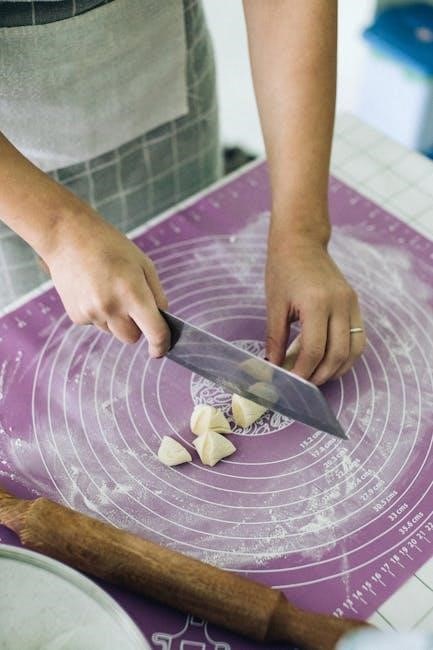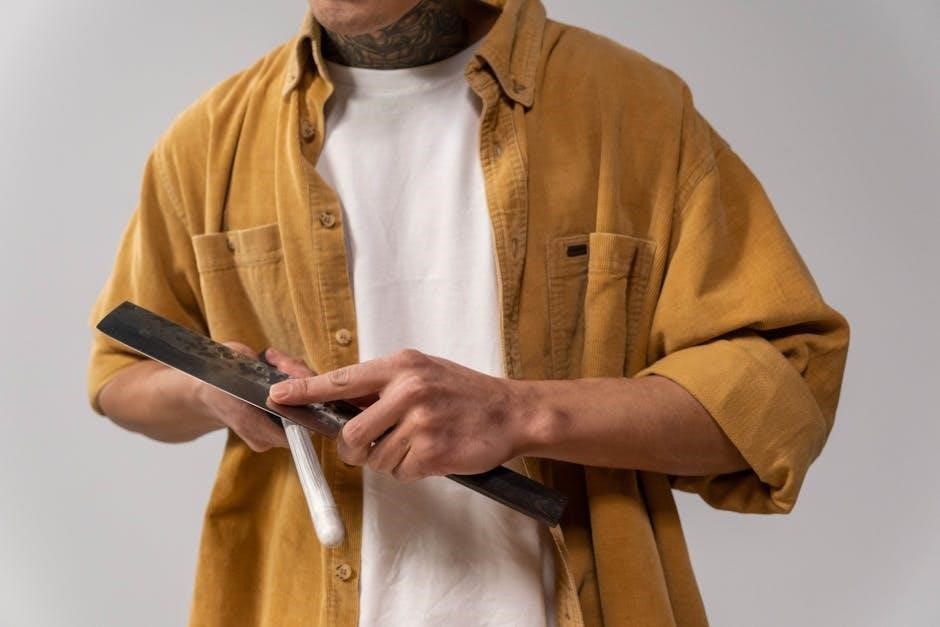Knife sharpening is a crucial skill for chefs and home cooks, enhancing safety and efficiency in the kitchen. This guide provides a comprehensive overview of various sharpening tools and techniques, helping you achieve professional results at home.
Importance of Knife Sharpening

Sharp knives are safer, as they require less force and reduce the risk of accidents. A dull knife can slip and cause injuries, making sharpening a critical safety measure. Additionally, sharp knives are more efficient, allowing for cleaner cuts and reducing food waste. They also preserve the quality of ingredients by minimizing tearing and crushing. Regular sharpening extends the lifespan of a knife by preventing excessive wear and tear. Furthermore, a sharp knife enhances precision and control, making cooking and other tasks more enjoyable. Properly maintaining a knife through sharpening is both practical and cost-effective, ensuring optimal performance and longevity.
Basic Tools and Equipment Needed
To effectively sharpen a knife, you’ll need the right tools. A whetstone is a popular choice, available in water or oil-based options, offering precise control over the sharpening process. Electric knife sharpeners provide convenience and speed, ideal for beginners. A honing rod or sharpening steel is essential for maintaining the edge between sharpening sessions. Diamond stones are another durable option for consistent results. Ceramic rods are great for fine-tuning and polishing. Additionally, sharpening guides can help maintain the correct angle, especially for those new to sharpening. Lastly, always use honing oil or water with your stone to lubricate and prevent overheating. These tools ensure you can achieve a razor-sharp edge efficiently and safely.

Understanding Knife Sharpening Techniques
Mastering knife sharpening techniques involves understanding angles, strokes, and tool usage to maintain sharpness and effectiveness, ensuring precise cuts and enhanced culinary performance.
Whetstone Sharpening Method
The whetstone sharpening method is a traditional and effective way to sharpen knives, requiring patience and practice. Begin by soaking the stone in water or oil for 10-15 minutes. Place the stone on a stable surface and hold the knife at the desired angle, typically between 15° and 20°. Draw the blade across the stone in smooth, consistent strokes, moving from the heel to the tip. Repeat on the other side to ensure an even edge. After raising a burr, flip the stone to a finer grit and refine the edge. This method allows for precise control, resulting in a razor-sharp blade ideal for culinary use.
Electric Knife Sharpeners

Electric knife sharpeners offer a convenient and efficient way to sharpen knives, ideal for those seeking quick results. These devices typically feature preset angles and multiple stages, from coarse grinding to fine polishing. Simply draw the blade through the slots, following the machine’s guidance, to achieve a sharp edge. Electric sharpeners are user-friendly and require minimal skill, making them perfect for beginners. However, they may remove more metal than traditional methods, so caution is advised for expensive or high-quality knives. Regular maintenance, such as cleaning the sharpening wheels, ensures optimal performance. Electric sharpeners are a great option for consistent, hassle-free sharpening in any kitchen or workshop setting.

Honing Rods for Maintenance
Honing rods are essential for maintaining a knife’s edge between sharpening sessions. They realign the blade’s microteeth, restoring sharpness without removing metal. Available in steel, ceramic, or diamond-coated models, honing rods are simple to use. Hold the rod vertically and draw the knife from heel to tip at a 15-20° angle, repeating on both sides. This process ensures the edge remains straight and razor-sharp. For beginners, marking the edge with a marker can help track progress. Regular honing extends the knife’s sharpness and reduces the need for frequent sharpening. Proper care, such as cleaning and storing the rod dry, prolongs its effectiveness. Honing rods are a quick, efficient tool for knife maintenance and edge preservation.

Step-by-Step Sharpening Process
Start with a coarse stone to raise a burr, then progress to finer grits for polishing. Maintain consistent angles and use light pressure to refine the edge evenly.
Preparing the Knife and Tools
Before sharpening, inspect the knife for any damage or nicks. Clean the blade to ensure debris doesn’t interfere with the process. Select a suitable sharpening stone, such as an Arkansas or water stone, and place it on a stable surface. If using an oil stone, apply a few drops of honing oil to the surface. For beginners, marking the knife’s edge with a Sharpie can help track progress. Secure the stone with a non-slip mat or damp cloth to prevent movement. Ensure the knife is dry and free of contaminants. Properly preparing your tools and knife is essential for achieving optimal results during the sharpening process.
Establishing the Correct Angle
Establishing the correct angle is critical for effective knife sharpening. Most knives are sharpened at a 15–20° angle, with lighter cuts requiring a sharper edge (lower angle) and heavier use needing a more robust edge (higher angle). To maintain consistency, place the knife heel on the stone and tilt it to the desired angle. For visual learners, drawing a line on the blade with a marker can help track progress. Light pressure is key—let the stone do the work. Keeping the angle consistent ensures an even edge and prevents uneven wear. This step lays the foundation for achieving a razor-sharp blade, making it safer and more efficient for cutting tasks.
Refining the Edge
Refining the edge is the final step in achieving a razor-sharp knife. After establishing the angle and sharpening, use progressively finer grit stones or a honing rod to polish the blade. Light, consistent strokes remove micro-serrations, creating a smooth edge. For precision, alternate strokes on both sides of the blade. A leather strop can further refine the edge, enhancing sharpness and durability. Test the edge with a thumbnail or paper to ensure it’s razor-sharp. Proper refinement ensures the knife cuts cleanly and maintains its edge longer. This step is crucial for both functionality and safety, making it a key part of mastering knife sharpening techniques.

Maintaining and Caring for Your Knife
Proper cleaning, drying, and storage are essential for preserving your knife’s edge. Regular maintenance prevents rust and ensures longevity. Store knives in a dry place or use a protective sheath to avoid damage and corrosion.

Post-Sharpening Care
After sharpening, always thoroughly dry your knife to prevent rust, especially for carbon steel blades. Apply a light coat of food-grade mineral oil to protect the metal. Avoid exposing the knife to harsh chemicals or acidic substances. Store the knife in a dry place, such as a sheath or knife block, to maintain its edge and prevent accidental damage. Regularly cleaning and drying the knife after use ensures longevity. For added protection, consider honing the blade periodically to maintain sharpness and realign the edge. Proper post-sharpening care extends the life of your knife and keeps it in optimal condition for consistent performance.
Storage and Rust Prevention
Proper storage is essential to maintain your knife’s edge and prevent rust. Store knives in a dry place, such as a sheath, knife block, or magnetic strip. Avoid humid environments, as moisture can cause rust, especially on carbon steel blades. Clean and dry the knife thoroughly before storage. Applying a thin layer of food-grade mineral oil to the blade provides additional protection against rust. For long-term storage, consider using a protective pouch or wrapping the knife in a dry cloth. Regularly inspecting stored knives ensures they remain in optimal condition. Proper storage and rust prevention practices extend the lifespan of your knife and preserve its sharpness for future use.

Safety Tips and Common Mistakes
Always cut away from your body and keep fingers away from the blade. Common mistakes include improper angle maintenance and using excessive pressure, which can damage the knife or cause accidents; Proper safety precautions ensure a safe and effective sharpening process.
Safety Precautions
Knife sharpening requires attention to safety to avoid injuries. Always wear protective gloves and ensure the work area is clear of distractions. Keep fingers away from the blade edge, and maintain a firm grip on the knife handle. Use proper lighting to clearly see the edge being sharpened. Never sharpen toward your body, as this increases the risk of accidents. Avoid applying excessive pressure, which can cause the knife to slip. Store sharpening tools and knives securely after use to prevent mishandling. Regularly inspect tools for damage and replace worn-out items. Proper safety precautions ensure a safe and effective sharpening process.
Avoiding Common Errors
Common mistakes during knife sharpening can lead to a dull or uneven edge. One major error is applying too much pressure, which can damage the blade or the sharpening tool. Another mistake is using the wrong angle, as inconsistent angles result in an ineffective edge. Forgetting to check the blade’s progress frequently can lead to over-sharpening, wasting the knife’s material. Additionally, neglecting to maintain sharpening tools, such as cleaning or flattening whetstones, reduces their efficiency. Avoid these errors by staying focused, using the correct technique, and regularly inspecting both the knife and tools. Proper attention ensures a sharp, even edge and extends the life of your tools and knives.
Mastering knife sharpening enhances your culinary skills and prolongs your tools’ lifespan. By understanding the right techniques and tools, you can achieve razor-sharp edges effortlessly. Regular practice ensures consistency, while proper care prevents rust and maintains sharpness. Remember, sharp knives are safer and more efficient, making cooking enjoyable. Avoid common errors like incorrect angles or excessive pressure to preserve your blades. With patience and dedication, you’ll become proficient in sharpening, ensuring your knives remain in prime condition for years. Happy sharpening!
